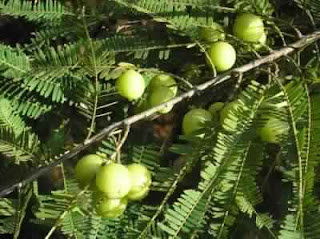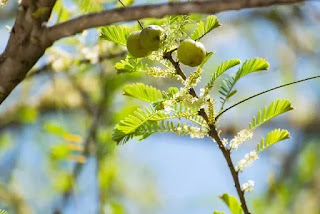what is amla (indian gooseberry)? use, side effects and faq question ansures.
The English name of Amla: Indian Gooseberry, indicates that it is indigenous to India. Although all parts of the tree have medicinal importance, but it is the main fruit. Charaka has specifically referred to it as a great chemical that helps protect people from disease and keeps away the manifestations of premature aging.
Amla fruit is pungent, cooling, refrigerant, diuretic, laxative, achromatic, antipyretic, aphrodisiac modifier, tonic and trivial. It is the richest natural source of vitamin C. 100 grams Amla has about 700 mg. Vitamin C, which is thirty times the amount found in oranges. In the advertisement of vitamin C, it contains calcium, iron, protein, garlic and tannic acid, sugar, phosphorus, carbohydrates, etc. Amla juice is given. Tonic, diuretic and anti-bile measures. It is also helpful in burning, thirst, indigestion and other complaints of digestive system.
Amla juice and Amla powder contain some powerful antioxidants that can help promote overall health in people. It can be drunk or applied to your body and hair. It is also known to strengthen your immune system and help treat various diseases effectively.
Names of Indian Gooseberry
Indian name: Amalaki, Dhatriphala, Amla, Aovla, Awla
- Family name: Euphorbiaceae
- Sanskrit: Aamalki, Dhatriphala, Shiva
- Hindi: Amla, Aovla, Awla
- English: Gooseberry, Emblic
- Myrobalan
- Gujarati: Aola, Amla
- Bengali: Aamalki
- Kannada: Nellaka
- Malayalam: Nellimaram
- Marathi: Aawalkanti, Aaola
- Tamil: Nelli
- Telgu: Usirikaya
also read this article Health Benefits of Cinnamon
Amla's Medicinal Properties
- Antioxidant
- Anti-fungal
- Anti-bacterial
- Nematidil
- Anabolic
- Anti-hepatoxic
- Anti-hyperhydrosis
- Anti-inflammatory
- Anti-histaminic
- Anti-viral
- anti-mutagenic
- yeast inhibitor
- Anti-spasmodic
- hypolipidemic
Nutritional value Amla (100 g)
Energy 58-kilo calorieFiber 3.4%
Proteins 0.5%
Fat 0.1%
Carbohydrates 13.7 g
Calcium 50 %
Iron 1.2 mg
Carotene 9 microgram
Thiamine 0.03mg
Riboflavin 0.01mg
Nicene 0.2mg
Vitamin 600mg
Amazing Use Of Amla
- Amla makes the body strong, removes toxins from the body and improves the defense mechanism of the body.
- It is an essential vitamin to improve eyesight
- Taking amla juice in between meals will remove weakness of body, heart and mind.
- Massaging the scalp with amla oil, induces sleep and is good for hair. Prevents premature graying of hair.
- Wash eyes daily, soak them in amla with water in the morning and drink water to increase eyesight and relieve constipation.
- Add 2-4 gooseberry juice to each nostril to cure bleeding for the nose.
- Regulates blood sugar
- Very powerful anti-inflammatory herb.
- Amla, an amazing antioxidant and a natural source of vitamin C, helps to destroy free radicals.
- Amla is a powerful food for the brain.
- Studies show that gooseberry helps lower cholesterol
- Amla also helps in maintaining liver function.
- Hemoglobin increases red blood cell count
- Useful for cough, bronchitis, asthma
- Amla cleans the mouth, makes teeth strong
- Its decoction is used in high blood pressure and honey as an anthelmintic.
17. Control hair loss
Its internal use as well as its local application on the scalp helps to control hair loss. It stimulates hair follicles which promotes hair growth and also improves hair texture. This prevents premature graying of hair and dandruff.18. Increases eyesight
It is very useful in increasing eyesight. It also counts diseases like red eyes, itching and watering. It has also shown some good results in cataracts.19. Control sugar level
It is also very useful in control blood sugar level. Prepare a mixture of amla, berries and bitter gourd powder (same quantity). To control your diabetes, take a teaspoon of this mixture once or twice a day.20. Treat skin disorder
It is very useful in skin diseases because the sheet is virgin in strength. It prevents bile and thus helps in getting relief from all skin disorders caused by bile dominance. Regular intake of amla promotes shine on the skin and removes wrinkles or loosening of the skin.21. Maintaining body temperature
Amla juice when taken in the summer season, can keep the body cool from the intense heat of the sun. It is considered a shield for radiation and best protection from harmful ultraviolet rays, protecting the skin from harsh weather conditions and keeping one cool and hydrated.22. Strong hair growth
Applying Indian gooseberry juice on a scalp and mixing it with water brings back the energy and energy of the hair. You can add Amla powder with lemon juice to make hair stronger. Amla oil is used to massage the scalp. This will help strengthen the hair from the roots and bring a natural shine to the hair. Many people take Amalaras to get relief from stress.23. Blood purification
Amcarus after regular intake with honey is effective in relieving bronchitis as well as complications arising due to asthma. It also works in an ideal way to purify the blood. You can use this mixture to say goodbye to the problem of acidity. Pure honey can be added to address acidic issues. The antioxidant properties of Amla juice help to cleanse unwanted products from the blood and make them healthy.24. Source of nutrients
Amla is one of the integral ingredients present in Chyawanprash and Triphala. It also contains various vitamins and minerals which are beneficial for the healthy functioning of the body. Amla juice is considered to be a powerful antioxidant at the same time.25. Amla juice
To use it on your hair, you can add it to your shampoo or use it as a conditioner. Make sure you leave it for at least ten minutes to get the full benefit before taking it out. You can also massage it into your scalp before washing your hair.26. Amla powder
You can buy Amla powder in many health food stores or make your own Amla powder with fresh Amla. To do this you should not dry them in the sun, but in the shade to ensure that they retain the maximum amount of vitamin C. You can drink this powder to get your hair out from inside or just to eat amla. . The best way to use amla powder on your hair is to mix it with water to make a thick paste. You will need to massage it properly so that it reaches the length and roots of your hair. With this powder mixture you have to leave it for sixty minutes before washing it using hot water.27. Amla against cancer
Most research is examining amla as a way of preventing the development of lung and liver cancer, at least with chemotherapy, rather than using amla instead of chemotherapy. But when the dose of chemotherapy can be reduced, the unwanted effects are also reduced.also read this article 13 Health Benefits of Apple Cider Vinegar
Recommended Amla Dose
Children (ages 1 to 14): 40 to 50 mg
Teens (ages 15 to 18): 65 to 75 mg
Male (over 18 years of age): 90 mg
Females (over 18 years of age): 75 mg
Side Effect Of Amla
Bleeding disorders
Indian gooseberry can increase bleeding disorder in some people. So use Indian gooseberry with caution.Diabetes
Amla might decrease blood sugar levels. So use of amla with doctors advice whoMay suffer from diabetes.
Surgery
Indian gooseberry can increase the risk of bleeding during and after surgery.so stop take Indian gooseberry before surgery.Faq Questions Ansures
1. Does Amla powder help hair grow?
Its internal use as well as its local application on the scalp helps to control hair loss. It stimulates hair follicles which promotes hair growth and also improves hair texture. This prevents premature graying of hair and dandruff.2. What are the side effects of Amla?
Bleeding disordersIndian gooseberry can increase bleeding disorder in some people. So use Indian gooseberry with caution.
Diabetes
Amla might decrease blood sugar levels. So use of amla with doctors advice who
May suffer from diabetes.
Surgery
Indian gooseberry can increase the risk of bleeding during and after surgery.so stop take Indian gooseberry before surgery.
3 Can Amla regrow lost hair?
Applying Indian gooseberry juice on a scalp and mixing it with water brings back the energy and energy of the hair. You can add Amla powder with lemon juice to make hair stronger. Amla oil is used to massage the scalp. This will help strengthen the hair from the roots and bring a natural shine to the hair. Many people take Amla juice to get relief from stress.4 Is Amla cold or hot?
. It maintains a balance between the three doshas of air, bile and felgum (air, bile and phlegm).5. How much Amla powder should I take?
Infants (under age 1): 30 to 35 mgChildren (ages 1 to 14): 40 to 50 mg
Teens (ages 15 to 18): 65 to 75 mg
Male (over 18 years of age): 90 mg
Females (over 18 years of age): 75 mg
6.Can diabetics eat Amla?
Amla might decrease blood sugar levels. So use of amla with doctors advice whoMay suffer from diabetes.
Disclaimer: This article is not meant to provide health advice and is for general information only. Always seek the insights of a qualified health professional before embarking on any health program.











0 Comments